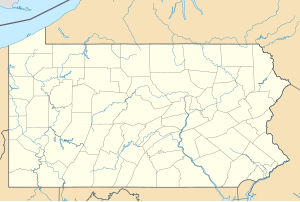Moon Lake Park
| Moon Lake State Forest Recreation Area | |
| Nature Park | |
|
Moon Lake
|
|
| Named for: Moon Lake | |
| Country | United States |
|---|---|
| State | Pennsylvania |
| County | Luzerne |
| Township | Plymouth |
| Coordinates | 41°15′12″N 76°02′52″W / 41.25333°N 76.04778°WCoordinates: 41°15′12″N 76°02′52″W / 41.25333°N 76.04778°W |
| Highest point | |
| - elevation | 1,350 ft (411.5 m) |
| Lowest point | |
| - elevation | 1,100 ft (335.3 m) |
| Area | 942 acres (381.2 ha) |
| Founded | 1968 |
| - County park | 1968 |
| - State forest recreation area | 2015 |
| Management | Pennsylvania Department of Conservation and Natural Resources |
| For public | Closed to camping, firewood permits, and hunting |
Moon Lake State Forest Recreation Area is a 942-acre (381 ha), recreation area within Pinchot State Forest in Plymouth Township, Luzerne County, Pennsylvania. It is open for mountain biking, hiking, fishing, bird watching, and nature study. The recreation area consists of open fields and woodlots surrounding Moon Lake, a 48-acre (19 ha), spring-fed lake. Moon Lake SFRA is in the Delaware and Lehigh National Heritage Corridor. It is located near Pennsylvania Route 29 on the western edge of the Scranton—Wilkes-Barre—Hazleton metropolitan statistical area.
The primary hydrological feature at Moon Lake Recreation Area is Moon Lake—a 48-acre (19 ha), spring-fed lake. The lake is located centrally in the park. Moon Lake resides in the Susquehanna River Basin—a Warm Water Fishery. It is a passageway for migrating fish. Specifically, Moon Lake is in the Hunlock Creek watershed—a Cold Water Fishery. The watershed of the lake covers 0.5 square miles (130 ha). Forested land serves as a riparian buffer from development around the lake. Throughout the park are many wetlands, spring speeds, vernal ponds, and small streams. The hydrological connection between Moon Lake and the Susquehanna River is as follows. Moon Lake empties into Tributary 28303, which empties into Tributary 28301, which merges into Hunlock Creek, and finally flows directly into the Susquehanna River. From there, water reaches the Chesepeake Bay and Atlantic Ocean.
Moon Lake Recreation Area has diverse habitats from upland forests to low-lying wetlands near the lake. The upland forests are part of the Appalachian-Blue Ridge forest ecoregion. Tree species include hickories, red maple, and tuliptree (Liriodendron tulipifera). On the lower slopes, red and white oaks are present. On the drier ridge tops and upper slopes, chestnut and both black and white oaks dominate. Conifer cover, including white pine (Pinus strobus) and eastern hemlock (Tsuga canadensis), is present throughout the park. The dense understory is various shrubs—particularly mountain laurel (Kalmia latifolia) and blackberry. Some invasive species are present including hay scented and New York ferns, striped maple, spicebush, black birch, and hornbeam.
...
Wikipedia


